By Jeffrey Ressner
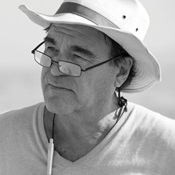 Oliver Stone described Born on the Fourth of July, his 1989 biopic of Vietnam veteran and anti-war activist Ron Kovic, as a drama in five acts. The film follows Kovic (Tom Cruise) as an All-American boy from Massapequa, New York, to Southeast Asia where a bullet severs his spine and leaves him a parapalegic, and his emergence as an eloquent and forceful political voice in the early ’70s.
Oliver Stone described Born on the Fourth of July, his 1989 biopic of Vietnam veteran and anti-war activist Ron Kovic, as a drama in five acts. The film follows Kovic (Tom Cruise) as an All-American boy from Massapequa, New York, to Southeast Asia where a bullet severs his spine and leaves him a parapalegic, and his emergence as an eloquent and forceful political voice in the early ’70s.
For the film’s final act, in which Kovic finally discovers his life’s purpose, Stone recreated veterans demonstrating at the 1972 Republican National Convention held in Miami Beach, Florida. The sequence was filmed over three days. Stretching the film’s estimated $17 million budget, Stone used 300-500 strategically-placed extras, along with clever camera and editing tricks (editors David Brenner and Joe Hutshing won an Academy Award) to replicate the actual event where Vietnam vets, Yippies, feminists and other protesters clashed with GOP delegates, Secret Service, and police.
With most of the picture already shot in anamorphic 2.35:1, Stone and cinematographer Robert Richardson decided to use “a jumble” of film stocks, including 16 mm, Super 16 and 35 mm to combine newly-shot material with grainy archival footage originally produced for the network news nearly two decades earlier. Stone employed this technique in future projects (The Doors, JFK, Natural Born Killers), but he originally began mixing various stocks out of necessity. As it turned out, Born on the Fourth of July won a DGA Award, an Oscar and a Golden Globe for best direction.
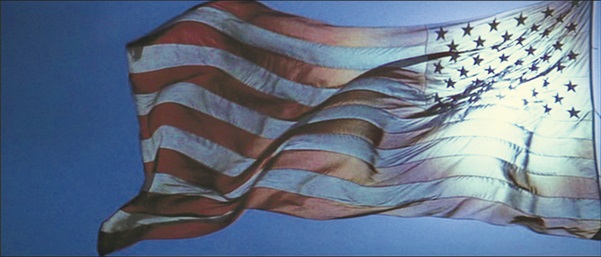
We were at the very end of the Dallas shoot when we saw this flag on the streets near the convention hall, just flapping in the wind, and we loved it. It was not a setup. There was some sun behind it, so we backlit it a bit, muted the color, and flipped the shot. The music, which you hear very faintly at first, is ‘When Johnny Comes Marching Home Again,’ a song sung by both sides during the American Civil War, but most often identified with the Confederacy. It made sense because there was a real civil war going on in America during the ’60s and early ’70s.
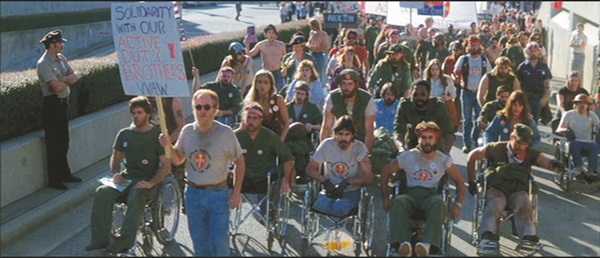
As the technocrane rises up and up, it swoops down and eventually the shot settles onto Ron. It’s a key shot, one long move on a technocrane. It’s beautiful, essential—it’s like a dance step to me. You see the whole line of protesters, and the camera basically does a 180. I deliberately buried Ron deep in the crowd because so far, the whole movie has been just about him. But now he’s joining history; he’s joining the crowd and is no longer an individual. Though he will reassert himself, he’s part of a larger movement in history now.
Here we finally find Ron after a long and intricate technocrane shot that’s moved over the crowd and even under it. Thank god for the technocrane, because I don’t think we could have gotten this without it. You don’t see Ron for a while and then you suddenly see him as just one of the guys, which is lovely. He is Johnny come marching home, and then, right after we’ve seen him, the camera rises back up again.
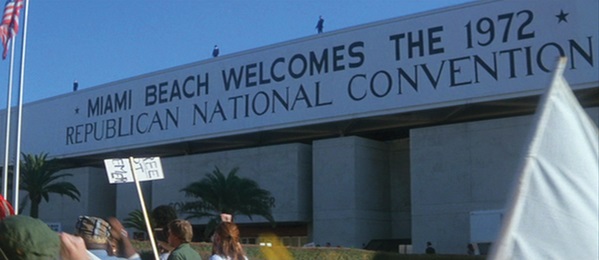
The audience doesn’t know where the shot is going as the camera moves up from Ron and we don’t know what’s going to happen next, because the last time we saw Ron was two or three years ago in Georgia [visiting the family of a soldier he mistakenly killed in a “friendly fire” incident in Vietnam]. Now we’ve found him as the camera rises to reveal where he’s going: the 1972 GOP Convention. This is a big shot that we filmed in Dallas where we found a merchandise mart to take the place of the Miami Beach Convention Center. Look closely and you can make out the Secret Service agents lined up on the roof of the hall.
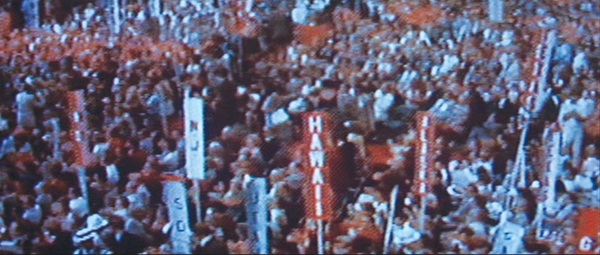
This is actual convention footage from 1972. It’s blown up from 16 mm to 35 mm and you can see the big golf ball-sized grain from those days. The use of different film stocks starts jumping all around from here. After the first shot of Nixon, which was shown a few seconds earlier, we quickly pan over here to establish the convention floor filled with delegates. Then we moved to our own super-grainy 16 mm shot of the crowd, which closely matches the original convention look. This lets your eyes soften up to our shots which have fewer people and establishes our own look and matches the real footage nicely.
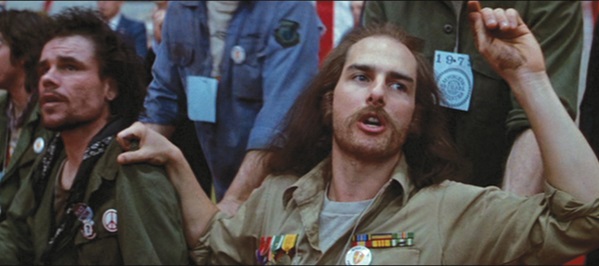
For this shot in which Ron is shown with other protesters, we used a lot of lo-mo [low-motion] Steadicam to establish Ron’s point of view, which is always a few feet lower than usual because he’s in a wheelchair. The Steadicam is a pain in the ass in the lower mode, but when you start to live in this world of Ron we had an important issue of subjectivity and so we needed to stay low. We got a beautiful 35 mm look here, which has crisp, clean colors, and full-out anamorphic. Let me tell you, it’s hard to go from an old 16 mm shot of Nixon at the convention to a big, new 35 mm look.
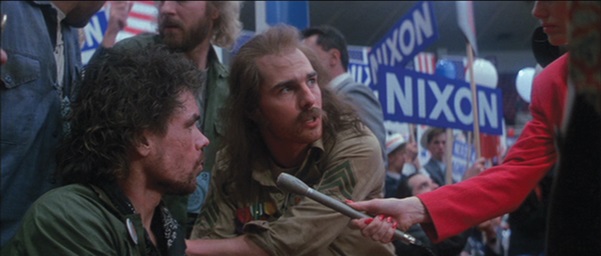
The reporter had to break through the ring of onlookers, and we showed that with a handheld shot in high-quality 35 mm lo-mo, looking up from Ron’s point of view. We didn’t do that many wide shots from Ron’s perspective, maybe just two or three. The reporter asks Ron, “What do you have to say to these people?” It was actually taken from a news telecast in Miami. Ron replies and the dialogue is the kind of thing he was saying constantly from 1969 to 1972. I was criticized for connecting it [specifically] to the GOP Convention, but I don’t think I was wrong to do it because it summarized the years in which Ron turned against the war.
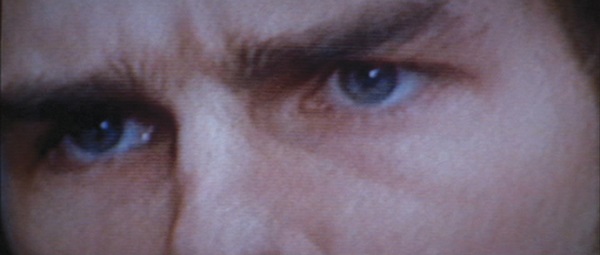
From the 35 mm look in the previous frame, we moved back to a grainy 16 mm close-up, then zoomed to an extreme close-up on Ron who is talking about “the people of this country.” So now we’ve established the [visual] link between the real convention and Nixon, our own grainy 16 mm look, and our own 35 mm look—all three have been done early. At the same time you hear Nixon continuing his speech.
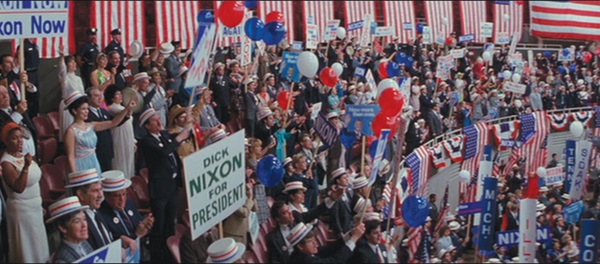
This was shot from the hall’s upper balcony. As the camera swings around you can almost notice the size of our hall, which is not as big as the real one and doesn’t go back very far. We’re staying in 35 mm, and this is one of the biggest views of the hall we have. You can see from the back of the convention center to the front, which is where Nixon is supposed to be. It’s not deep, but it’s blocked by a lot of signage and extras. Joe Reidy was my 1st AD, and he was very helpful in moving the crowds—maybe 500 tops—around to block the obvious shortcomings of the location. It’s all illusion, and we were constantly aware of our edges.
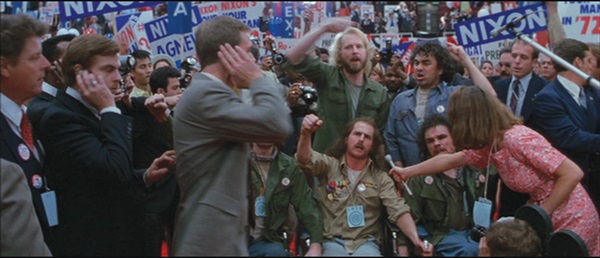
As Ron talks about “a divided people,” we see the Secret Service guys [on the left] getting a message over their earpieces to “get these people out of there.” This is a 35 mm shot, almost from Nixon’s point of view [at the podium], and from here the action goes to another, hyper level. A heavy guy kicks it off by spitting on Ron while the female reporter is very insistent about breaking through the ring—she’s trying to get the story and Ron is trying to get the story out. Nixon is still speaking and you get the feeling from this shot that the Secret Service are going to get the protesters out of there, and that’s when they all start to fight.
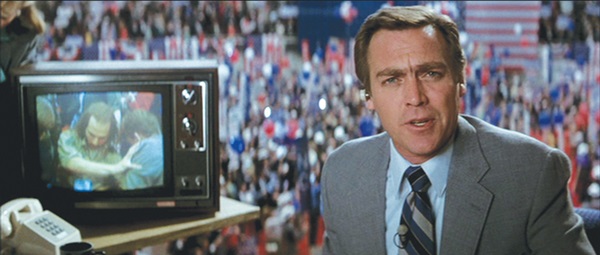
This is one of the biggest and widest shots we have in the whole scene. We used the news anchor to show that there was a serious disruption and Ron was indeed being forcibly removed from the hall, even if this protest wasn’t as violent as say, a Wilshire Boulevard march that happened some months earlier in L.A. We used as many extras as we could gather that day, and the newsman was played by the late Chip Moody, a local broadcaster from Dallas. You can see a little bit of Ron there on his monitor as he’s being pulled out from the hall and the anchor hears about “some kind of scuffle” down on the convention floor.
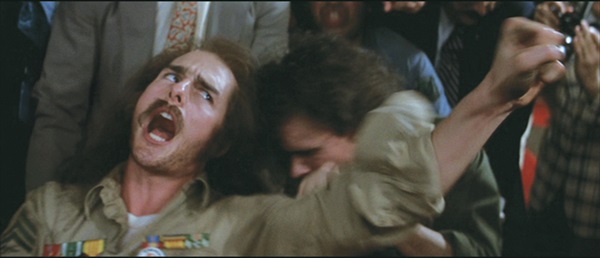
Tom worked very hard on this and every other scene. It was very much a scripted film, not a lot of improvised dialogue or ad libs, even in a scene like this. By this time, Tom and I had worked together for weeks. He rehearsed extensively, knew how to use the wheelchair and was extremely self sufficient. That’s not to say that we didn’t have conferences, but on a day like this, I might have been upstairs working with more of our non-professional players, like the news anchor, but I’d be talking to Tom the whole time.
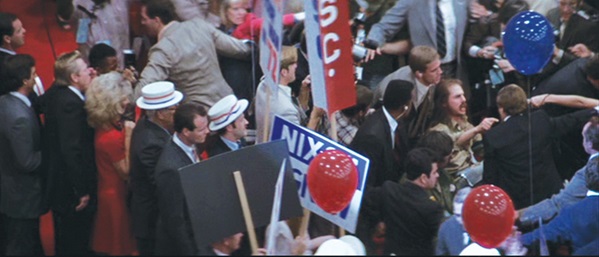
The Secret Service are trying to get Ron out of the hall and the veterans have locked their chairs down, and that makes it harder for them to be dragged out. In this sequence there’s also a quick cut to a police informant, the guy who’s been pushing Ron’s wheelchair, flashing his badge. That was based on a real incident. It was very noisy and there was a lot of racket with all the extras and Secret Service agents being directed. There were some issues of sound in which we had to ask extras to quiet down and mimic yelling without actually doing so. Fortunately we had Tom miked very closely.
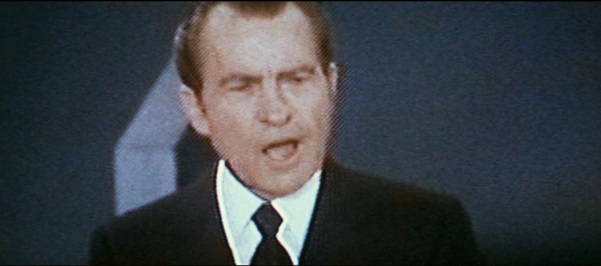
We had three shots of Nixon in the sequence, and they were key because he set the tone of the convention. You believe you’re there because of these shots and the exuberance of the extras. The footage of real people intercut with the 16 mm grainy footage built up the idea it was real. It’s illusion created through editing. You couldn’t have done a direct cut from 16 mm Nixon to Ron in 35 mm anamorphic; it would have looked bad. It’s the old suspension of disbelief. The sequence works because of the cutting. How do you re-create an entire political convention? We couldn’t. All we could do was rent a little hall and use logistics to make it work.